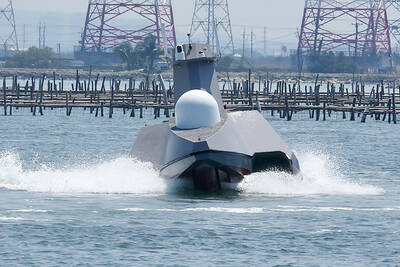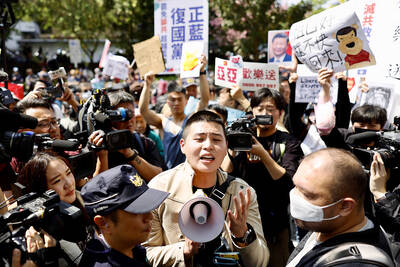Accidents are the leading cause of death for young people in Taiwan, accounting for almost 50 percent of all youth deaths, officials at the Department of Health said yesterday.
Accidents were the second-highest cause of all deaths in Taiwan last year.
Those were the most sobering facts revealed by the health department yesterday at a press conference held to raise public awareness of safety issues, precisely because of the high rates of accidental death, particularly among children under the age of 18.
Traffic accidents were the main killer, accounting for 43 percent of all accidental deaths, taking 5,526 lives last year.
"More than 70 percent of accidents are preventable," said Huang Fu-yuan (
According to the department's statistics, 12,960 people died as a result of accidents last year. Traffic accidents, falling, drowning, suffocation, poisoning and burns were the most common accidents. Fatal accidents in which the deceased were 65 or under were mostly traffic accidents, while children mostly died from suffocation.
There were 2,347 deaths from earthquakes last year, which were included in the statistics for accidental deaths. The number of other accidental deaths was 10,613.
"More than four times as many people died from other types of accidents than died because of earthquakes," Huang said. "Most of these deaths did not result from unavoidable catastrophes and should be preventable."
For people under 24, deaths from accidents exceeded deaths from cancer, the second biggest killer in this age group, by more than five times. "It's such a waste of these young lives," Huang said.
Taiwan's rate of accidental deaths is far higher than other developed countries, except South Korea, according to the most recent report by the WHO in 1996.
"What is of most concern is that our rate of child accident mortality is consistently the highest," Huang said. "If the rate would only decrease by the tiniest margin, then I would see it as the most satisfying accomplishment of my term."
Huang, who is also a pediatrics professor, has lectured on accidents involving children for more than 20 years.
"This high mortality rate has never decreased over the past three decades, regardless of how much we have appealed to people," Huang said.
Some fatalities result from suffocation when children are left alone in cars. "The parents cry when these tragedies happen, but I have never seen any of them charged with neglect," said Chen Tzay-Jinn (陳再晉), the department's head of health promotion, who added that parents must develop a basic sense of safety.
"We [doctors] can cure many complex diseases, but we cannot reduce easily preventable accidents," said pediatrician Wu Tzu-tsung (
Many accidents involving children happen within the family. Usually parents pay particular attention to kitchens or bathrooms, which are widely considered the most dangerous places in the home, according to Huang.
"But the living room has been found to be the most dangerous place and many parents ignore the potential dangers there," he said.
Reflecting on his long years of clinical experience, Huang said, "Don't allow children to leave marbles on living room floors. Watch out for sharp angles on tables or chairs; to avoid scalding,don't let the table cloth hang over the edge of the table.
"With this simple awareness, we can reduce the infant accident rate by at least half," Huang said.

ENDEAVOR MANTA: The ship is programmed to automatically return to its designated home port and would self-destruct if seized by another party The Endeavor Manta, Taiwan’s first military-specification uncrewed surface vehicle (USV) tailor-made to operate in the Taiwan Strait in a bid to bolster the nation’s asymmetric combat capabilities made its first appearance at Kaohsiung’s Singda Harbor yesterday. Taking inspiration from Ukraine’s navy, which is using USVs to force Russia’s Black Sea fleet to take shelter within its own ports, CSBC Taiwan (台灣國際造船) established a research and development unit on USVs last year, CSBC chairman Huang Cheng-hung (黃正弘) said. With the exception of the satellite guidance system and the outboard motors — which were purchased from foreign companies that were not affiliated with Chinese-funded

PERMIT REVOKED: The influencer at a news conference said the National Immigration Agency was infringing on human rights and persecuting Chinese spouses Chinese influencer “Yaya in Taiwan” (亞亞在台灣) yesterday evening voluntarily left Taiwan, despite saying yesterday morning that she had “no intention” of leaving after her residence permit was revoked over her comments on Taiwan being “unified” with China by military force. The Ministry of the Interior yesterday had said that it could forcibly deport the influencer at midnight, but was considering taking a more flexible approach and beginning procedures this morning. The influencer, whose given name is Liu Zhenya (劉振亞), departed on a 8:45pm flight from Taipei International Airport (Songshan airport) to Fuzhou, China. Liu held a news conference at the airport at 7pm,

AIR SUPPORT: The Ministry of National Defense thanked the US for the delivery, adding that it was an indicator of the White House’s commitment to the Taiwan Relations Act Deputy Minister of National Defense Po Horng-huei (柏鴻輝) and Representative to the US Alexander Yui on Friday attended a delivery ceremony for the first of Taiwan’s long-awaited 66 F-16C/D Block 70 jets at a Lockheed Martin Corp factory in Greenville, South Carolina. “We are so proud to be the global home of the F-16 and to support Taiwan’s air defense capabilities,” US Representative William Timmons wrote on X, alongside a photograph of Taiwanese and US officials at the event. The F-16C/D Block 70 jets Taiwan ordered have the same capabilities as aircraft that had been upgraded to F-16Vs. The batch of Lockheed Martin

GRIDLOCK: The National Fire Agency’s Special Search and Rescue team is on standby to travel to the countries to help out with the rescue effort A powerful earthquake rocked Myanmar and neighboring Thailand yesterday, killing at least three people in Bangkok and burying dozens when a high-rise building under construction collapsed. Footage shared on social media from Myanmar’s second-largest city showed widespread destruction, raising fears that many were trapped under the rubble or killed. The magnitude 7.7 earthquake, with an epicenter near Mandalay in Myanmar, struck at midday and was followed by a strong magnitude 6.4 aftershock. The extent of death, injury and destruction — especially in Myanmar, which is embroiled in a civil war and where information is tightly controlled at the best of times —